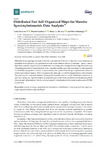Distributed Fast Self-Organized Maps for Massive Spectrophotometric Data Analysis

Use este enlace para citar
http://hdl.handle.net/2183/35358
A non ser que se indique outra cousa, a licenza do ítem descríbese como Atribución 4.0 Internacional (CC BY 4.0 )
Coleccións
- Investigación (FIC) [1685]
Metadatos
Mostrar o rexistro completo do ítemTítulo
Distributed Fast Self-Organized Maps for Massive Spectrophotometric Data AnalysisData
2018-11Cita bibliográfica
C. Dafonte, D. Garabato, M.A. Álvarez, and M. Manteiga, "Distributed Fast Self-Organized Maps for Massive Spectrophotometric Data Analysis", Sensors, vol. 18, n. 5, 1419, 2018, https://doi.org/10.3390/s18051419
Resumo
[Abstract]: Analyzing huge amounts of data becomes essential in the era of Big Data, where databases are populated with hundreds of Gigabytes that must be processed to extract knowledge. Hence, classical algorithms must be adapted towards distributed computing methodologies that leverage the underlying computational power of these platforms. Here, a parallel, scalable, and optimized design for self-organized maps (SOM) is proposed in order to analyze massive data gathered by the spectrophotometric sensor of the European Space Agency (ESA) Gaia spacecraft, although it could be extrapolated to other domains. The performance comparison between the sequential implementation and the distributed ones based on Apache Hadoop and Apache Spark is an important part of the work, as well as the detailed analysis of the proposed optimizations. Finally, a domain-specific visualization tool to explore astronomical SOMs is presented.
Palabras chave
Remote sensing
Computational astrophysics
Distributed computing
Fast self-organized maps
Apache Hadoop
Apache Spark
Computational astrophysics
Distributed computing
Fast self-organized maps
Apache Hadoop
Apache Spark
Descrición
This article belongs to the Special Issue Selected Papers from UCAmI 2017 – the 11th International Conference on Ubiquitous Computing and Ambient Intelligence)
Versión do editor
Dereitos
Atribución 4.0 Internacional (CC BY 4.0 )






